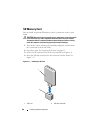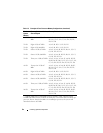
92 Installing System Components
Your system hardware supports Non-Uniform Memory Architecture (NUMA).
Each processor has its own memory controller and local memory for reduced
access times, but it can also access memory from another processor. This
architecture improves system performance if an operating system is installed
that supports this feature.
NOTICE: To enable NUMA, run the System Setup program and disable the Node
Interleaving option. See "Using the System Setup Program" on page 43.
General Memory Module Installation Guidelines
To ensure optimal performance of your system, observe the following
guidelines when configuring your system memory.
• Memory modules m
ust be installed in pairs
, beginning with the first two
sockets in each set of memory modules. These sockets are marked by white
retention levers.
• All memory modules must be identical in speed and technology. The two
memory modules in each pair must be the same size.
Memory can either be installed in a two-processor configuration (Table 3-1)
or a four-processor configuration (Table 3-2).
Table 3-1. Examples of Two-Processor Memory Configurations
Total
System
Memory
Memory Modules –
Number, Size and Speed
Memory Module Locations
2 GB Four 512 MB, 667 MHz A1, A2, B1, B2
4 GB Four 1 GB, 667 MHz A1, A2, B1, B2
4 GB Eight 512 MB, 667 MHz A1, A2, A3, A4, B1, B2, B3, B4
6 GB Twelve 512 MB, 667 MHz A1, A2, A3, A4, A5, A6, B1, B2, B3, B4, B5,
B6
8 GB Four 2 GB, 667 MHz A1, A2, B1, B2
8 GB Eight 1 GB, 667 MHz A1, A2, A3, A4, B1, B2, B3, B4
16 GB Four 4 GB, 667 MHz A1, A2, B1, B2
16 GB Eight 2 GB, 667 MHz A1, A2, A3, A4, B1, B2, B3, B4


















